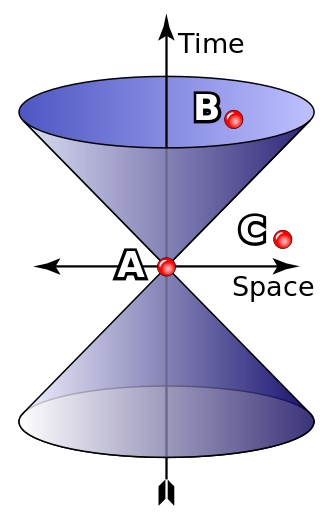Now? There Is No Now. Only Then.
by Kim Pederson…….
Thought to ponder, from John Banville’s novel ancient light:
Even here, at this table, the light that is the image of my eyes takes time, a tiny time, infinitesimal, yet time, to reach your eyes, and so it is that everywhere we look, everywhere, we are looking into the past.
If you’re thinking “he [me] must be reading that Time Travel book again,” you’d be right. If you are exceedingly discerning and/or prescient, you might even be thinking “now he’s going to pretend he understands Einstein’s special theory of relativity.” Once again, correctomundo. Well, sort of.

I needed a visual. Hey, it does mention space and time at least.*
The STR, put extremely briefly, defines the relationship between space and time. Rather than try and fail to explain this myself (as if I could), I bow to the Dummies website. The STR “created a fundamental link between space and time…. If you move fast enough through space, the observations that you make about space and time differ somewhat from the observations of other people, who are moving at different speeds.” This effect is known as time dilation, “when the time moving very quickly appears to pass slower than on earth” (see Interstellar). Put even more simply by the HowStuffWorks guy, “Time is not a physical thing. Time is an experience, and my time is not your time.”
It wasn’t long after Einstein put out the STR that “space” and “time” became “space-time” or, to use one of Doctor Who’s favorite phrases, the “space-time continuum.” As the song goes, you can’t have one without the other. Our perception of reality, whatever that is, depends on this.
So where am I? Back to square one I guess. Even though our world can only function now, thanks initially to railroads and the telegraph, due to time being standardized, universalized, synchronized, or whatever, we all experience time differently. We all travel through space at different speeds. Our senses and cognition are perpetually catching up to what has already happened.
That last statement prompts a revelation of sorts. Everyone on earth is speaking or writing incorrectly when they use the present tense because, well, there is no present that we can perceive. To be accurate, we need to eliminate the now in our interactions. This will take some adaptation, changing, for example, greetings like “how are you doing?” to “how were you doing?” when you meet, sorry, met someone you know, er, knew on the street. Sounds doable, don’t you think? Wait, what am/was I saying? It’s already done.
* Illustration of a light cone [whatever the heck that is]. Public Domain.
~~~~~~~~~~
Visit Kim Pederson’s blog RatBlurt: Mostly Random Short-Attention-Span Musings.

